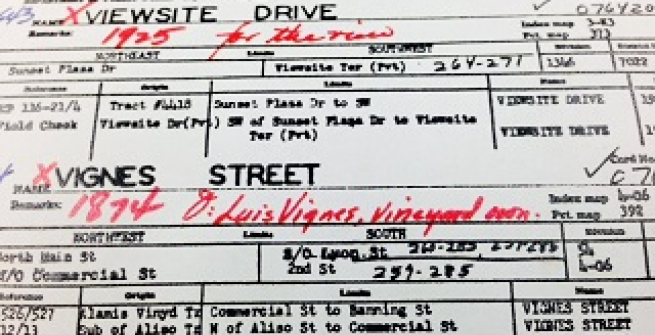What’s in a name? The stories behind the names of the streets, avenues, roads, and boulevards of Los Angeles reveal much about the history of our city, from its beginning as a tiny pueblo to today's sprawling metropolis of 3.8 million. A list of L.A. street names provides a “who’s who” of founders, prominent families, politicians, and real estate developers that reflects our city’s political, cultural, and economic growth.
Vignes Street is known to many City of Los Angeles employees as the location of the City‘s Personnel Department, the site of many agonizing interviews. The street is named after Jean Louis Vignes, a native of the Bordeaux wine region of France. Seeing potential for a successful wine industry in Los Angeles, Vignes imported cuttings of the best varieties from France to plant in his vineyard, El Aliso, located where Union Station is now. The winery and Aliso Street were both named for a large sycamore tree that stood near the entrance to the vineyard.
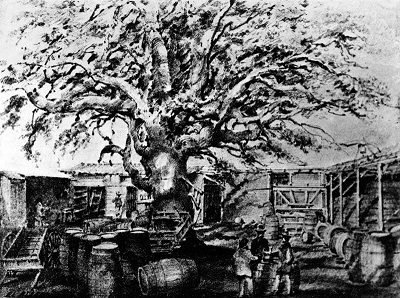
Photo of a drawing by Edward Vischer of El Aliso at Los Angeles, the old Vignes wine establishment.
Speaking of vintners, Hoover Street is not named after President Herbert Hoover, but for Dr. Leonce Hoover. Dr. Hoover (nee Huber) was a military surgeon in Napoleon’s army. When he moved to Los Angeles in 1849, he changed his name to Hoover and became a vintner, also known for high quality grapes.
In 1849, the City Council hired Edward O.C. Ord to create the first official map of Los Angeles. The story goes that while Ord was laying out the city’s streets, he was smitten with a young woman named Trinidad de la Guerra, whom he nicknamed “mi primavera,” or “my springtime.” She was the granddaughter of Jose Francisco Ortega, the Spanish explorer credited with discovering San Francisco Bay. Ord paid tribute to her by naming a street Calle Primavera. Today we know it as Spring Street. Fifty years later, Ord was honored with his own thoroughfare, Ord Street, located in Chinatown.
Real estate developers most often named the thoroughfares in their tracts, commonly choosing names of family and friends. The deeply religious prohibitionist Harvey Wilcox and his wife Daieda Wilcox moved to Los Angeles from Kansas in 1884. After taking buggy rides through the undeveloped canyons to the west, the couple bought land in the Cahuenga Valley. They registered “Hollywood” as the name for their subdivision on February 1, 1887. Drawing up the grid for his property, Harvey named Wilcox Avenue after himself, and Ivar and Selma Avenues after his neighbor’s children who would cross his property every day on the way to and from school.
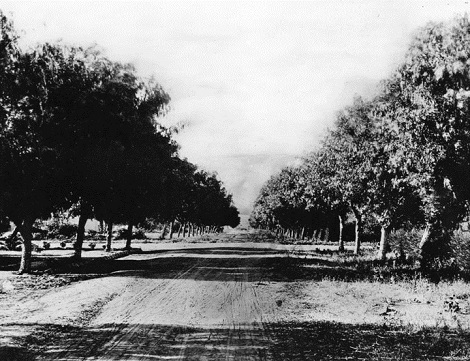
Wilcox Avenue in 1901
Sometimes developers followed a thematic system to convey a certain character or charm. The Silver Lake area was originally called “Ivanhoe” because it’s rolling green hills reminded Scotsman Hugo Reid of his homeland. Many of the streets still have Scottish-inspired names from this period (Rowena, Herkimer, and Kenilworth). The area started to be known as Silver Lake in 1907, after Water Commissioner Herman Silver guided construction of the reservoir.
Other street names reflect the layout of the street grid. Century Boulevard is 100 blocks south of the corner of 1st and Main, ground zero for the numbering of houses and blocks of streets since 1945. Tenth Street was renamed Olympic Boulevard in honor of the 1932 Olympics, though the name was not officially changed until some months after the conclusion of the games.
Still others honor more contemporary political figures and war heroes. The longest street name in the city belongs to Astronaut Ellison S. Onizuka Street in Little Tokyo. Weller Street was renamed in 1988 to honor the Japanese-American astronaut, one of the seven crew members who died in the space shuttle Challenger explosion in 1986.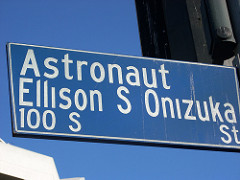
We have an amazing resource in the History Department to help unearth the stories behind street names: Street Names of Los Angeles, compiled by Bernice Kimball. Bernice specialized in cartography as one of the first female draftsmen in the Engineering Department of the City of Los Angeles. She became an expert on the maps of Los Angeles and frequently shared her knowledge with people researching the history and topography of L.A. As a result of her work, she developed an interest in the history of the city's street names. She belonged to Mensa (the high IQ society) and was an active member of the Los Angeles Historical Society.
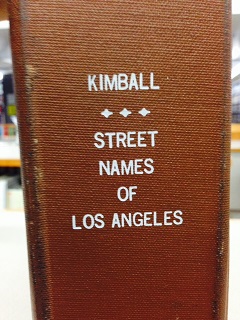
Each entry provides a wealth of information: the year the street was named, the origin of the name, tract numbers, and any previous names. The entry for Grand Avenue shows us that the street was named Grand in 1887 because the name is "more pleasing to residents than Charity St.," the thoroughfare's previous name. 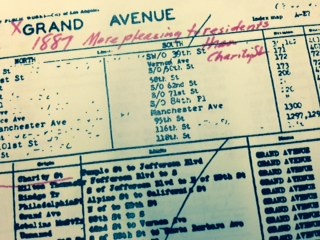
Entry for Grand Avenue
Street Names of Los Angeles is kept at the Reference Desk in the History Department.
The names of Los Angeles' streets serve as a road map through its past. So, the next time you are stuck in a miserable traffic jam on one of L.A.’s 6,500 miles of paved roads, take a moment to contemplate the history represented in the name of the pot-holed street beneath your tires.
Interesting web sites for further information on Los Angeles streets:
A blog post by map specialist Glen Creason on the 1849 O.C. Ord map:
http://www.lamag.com/citythinkblog/citydig-los-angeles-was-once-a-small-adobe-backwater/
Do you know the difference between a road and a lane? A boulevard and an avenue? Here's the full list of the official definitions from the Los Angeles County Street Naming Committee of the Los Angeles County Department of Regional Planning:
http://planning.lacounty.gov/assets/upl/project/street_name_05_definitions_spanish_prefixes_suffixes.pdf
Nathan Masters discusses the varying and clashing street grids:
http://www.kcet.org/updaily/socal_focus/history/la-as-subject/tracing-the-paths-through-las-past.html
Whatever became of those old streets? Steve Morse.org has compiled a chart on name changes to the streets as listed on the 1904 Chamber of Commerce map of Los Angeles:
http://stevemorse.org/census/changes/LosAngelesChanges2.htm
Books on two of Los Angeles’ most iconic streets:
Wilshire Boulevard: grand concourse of Los Angeles by Kevin Roderick
Tells the story of Wilshire Boulevard from its start as a dirt road through a barley field in 1895.
Sunset Boulevard: America’s dream street by Joe Kennelley & Roy Hankey
History of the boulevard that runs 27 miles from the old Plaza (downtown) to the Pacific Ocean.
